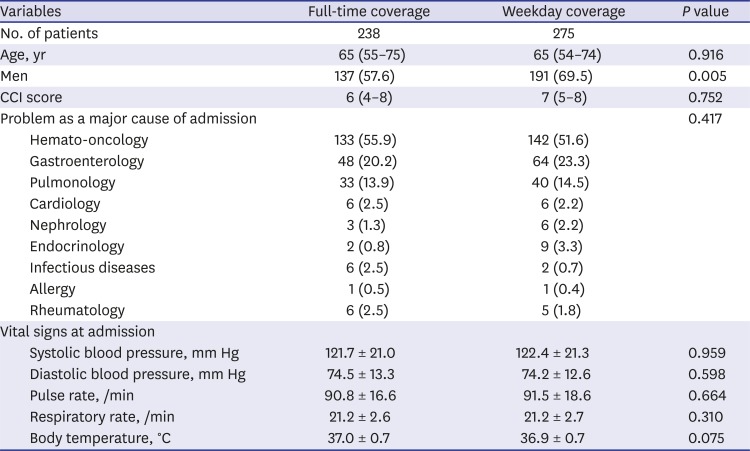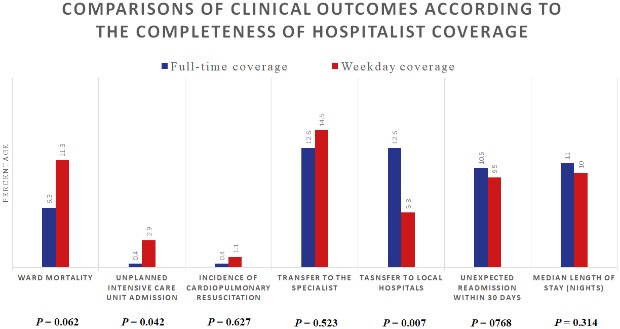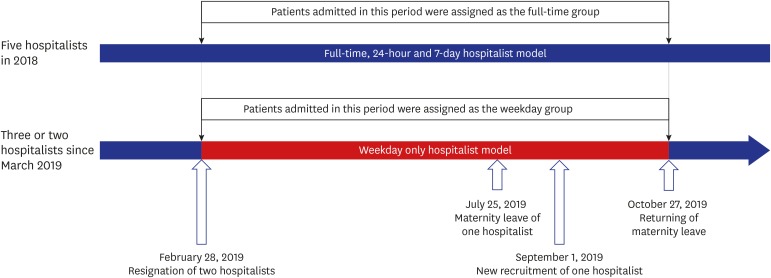1. Wachter RM. An introduction to the hospitalist model. Ann Intern Med. 1999; 130(4 Pt 2):338–342. PMID:
10068402.

2. Diamond HS, Goldberg E, Janosky JE. The effect of full-time faculty hospitalists on the efficiency of care at a community teaching hospital. Ann Intern Med. 1998; 129(3):197–203. PMID:
9696727.

3. Salim SA, Elmaraezy A, Pamarthy A, Thongprayoon C, Cheungpasitporn W, Palabindala V. Impact of hospitalists on the efficiency of inpatient care and patient satisfaction: a systematic review and meta-analysis. J Community Hosp Intern Med Perspect. 2019; 9(2):121–134. PMID:
31044043.

4. Wachter RM, Goldman L. Zero to 50,000 - the 20th anniversary of the hospitalist. N Engl J Med. 2016; 375(11):1009–1011. PMID:
27508924.

5. Jeon B, Kwon S. Health and long-term care systems for older people in the republic of Korea: policy challenges and lessons. Health Syst Reform. 2017; 3(3):214–223. PMID:
31514668.

6. Jang SI, Jang SY, Park EC. Trends of US hospitalist and suggestions for introduction of Korean hospitalist. Korean J Med. 2015; 89(1):1–5.

7. Eom JS. Operating the hospitalist system. J Korean Med Assoc. 2016; 59(5):342–344.

8. Kim J. The impact of hospitalist care in Korea. J Korean Med Sci. 2019; 34(25):e177. PMID:
31243936.

9. Ohn JH, Kim NH, Kim ES, Baek SH, Lim Y, Hur J, et al. An acute medical unit in a Korean tertiary care hospital reduces the length of stay and waiting time in the emergency department. J Korean Med Sci. 2017; 32(12):1917–1920. PMID:
29115071.

10. Lee JH, Kim AJ, Kyong TY, Jang JH, Park J, Lee JH, et al. Evaluating the outcome of multi-morbid patients cared for by hospitalists: a report of integrated medical model in Korea. J Korean Med Sci. 2019; 34(25):e179. PMID:
31243937.

11. Kim HW. The current status of hospital medicine in Korea, 2019. Korean J Med. 2019; 94(2):139–144.

12. Charlson ME, Pompei P, Ales KL, MacKenzie CR. A new method of classifying prognostic comorbidity in longitudinal studies: development and validation. J Chronic Dis. 1987; 40(5):373–383. PMID:
3558716.

14. Goodwin JS, Li S, Kuo YF. Association of the work schedules of hospitalists with patient outcomes of hospitalization. JAMA Intern Med. 2020; 180(2):215–222.

15. You JJ, Downar J, Fowler RA, Lamontagne F, Ma IW, Jayaraman D, et al. Barriers to goals of care discussions with seriously ill hospitalized patients and their families: a multicenter survey of clinicians. JAMA Intern Med. 2015; 175(4):549–556. PMID:
25642797.
16. Gott M, Ingleton C, Bennett MI, Gardiner C. Transitions to palliative care in acute hospitals in England: qualitative study. BMJ Support Palliat Care. 2011; 1(1):42–48.

17. Auerbach AD, Pantilat SZ. End-of-life care in a voluntary hospitalist model: effects on communication, processes of care, and patient symptoms. Am J Med. 2004; 116(10):669–675. PMID:
15121493.

18. Blecker S, Goldfeld K, Park H, Radford MJ, Munson S, Francois F, et al. Impact of an intervention to improve weekend hospital care at an academic medical center: an observational study. J Gen Intern Med. 2015; 30(11):1657–1664. PMID:
25947881.

19. Blecker S, Shine D, Park N, Goldfeld K, Scott Braithwaite R, Radford MJ, et al. Association of weekend continuity of care with hospital length of stay. Int J Qual Health Care. 2014; 26(5):530–537. PMID:
24994844.

20. van Walraven C. The influence of inpatient physician continuity on hospital discharge. J Gen Intern Med. 2019; 34(9):1709–1714. PMID:
31197735.

21. Epstein K, Juarez E, Epstein A, Loya K, Singer A. The impact of fragmentation of hospitalist care on length of stay. J Hosp Med. 2010; 5(6):335–338. PMID:
20803671.

22. Arabi Y, Alshimemeri A, Taher S. Weekend and weeknight admissions have the same outcome of weekday admissions to an intensive care unit with onsite intensivist coverage. Crit Care Med. 2006; 34(3):605–611. PMID:
16521254.

23. Gajic O, Afessa B, Hanson AC, Krpata T, Yilmaz M, Mohamed SF, et al. Effect of 24-hour mandatory versus on-demand critical care specialist presence on quality of care and family and provider satisfaction in the intensive care unit of a teaching hospital. Crit Care Med. 2008; 36(1):36–44. PMID:
18007270.

24. Nishisaki A, Pines JM, Lin R, Helfaer MA, Berg RA, Tenhave T, et al. The impact of 24-hr, in-hospital pediatric critical care attending physician presence on process of care and patient outcomes. Crit Care Med. 2012; 40(7):2190–2195. PMID:
22564956.

25. Vinh KP, Walston SL, Szychowski J, Hernandez SR. The effect of hospitalists on average length of stay. J Healthc Manag. 2019; 64(3):169–184. PMID:
31999267.

26. Lucas BP, Trick WE, Evans AT, Mba B, Smith J, Das K, et al. Effects of 2- vs 4-week attending physician inpatient rotations on unplanned patient revisits, evaluations by trainees, and attending physician burnout: a randomized trial. JAMA. 2012; 308(21):2199–2207. PMID:
23212497.







 PDF
PDF Citation
Citation Print
Print





 XML Download
XML Download